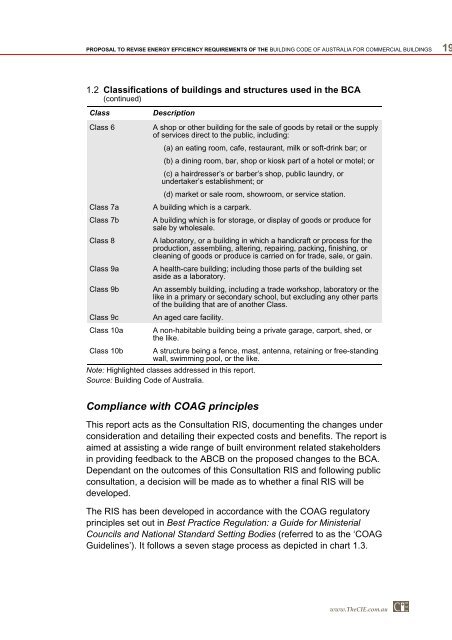PDF | 2 MB - Australian Building Codes Board
PDF | 2 MB - Australian Building Codes Board
PDF | 2 MB - Australian Building Codes Board
You also want an ePaper? Increase the reach of your titles
YUMPU automatically turns print PDFs into web optimized ePapers that Google loves.
PROPOSAL TO REVISE ENERGY EFFICIENCY REQUIREMENTS OF THE BUILDING CODE OF AUSTRALIA FOR COMMERCIAL BUILDINGS 19<br />
1.2 Classifications of buildings and structures used in the BCA<br />
(continued)<br />
Class<br />
Description<br />
Class 6<br />
Class 7a<br />
Class 7b<br />
Class 8<br />
Class 9a<br />
Class 9b<br />
Class 9c<br />
Class 10a<br />
Class 10b<br />
A shop or other building for the sale of goods by retail or the supply<br />
of services direct to the public, including:<br />
(a) an eating room, cafe, restaurant, milk or soft-drink bar; or<br />
(b) a dining room, bar, shop or kiosk part of a hotel or motel; or<br />
(c) a hairdresser’s or barber’s shop, public laundry, or<br />
undertaker’s establishment; or<br />
(d) market or sale room, showroom, or service station.<br />
A building which is a carpark.<br />
A building which is for storage, or display of goods or produce for<br />
sale by wholesale.<br />
A laboratory, or a building in which a handicraft or process for the<br />
production, assembling, altering, repairing, packing, finishing, or<br />
cleaning of goods or produce is carried on for trade, sale, or gain.<br />
A health-care building; including those parts of the building set<br />
aside as a laboratory.<br />
An assembly building, including a trade workshop, laboratory or the<br />
like in a primary or secondary school, but excluding any other parts<br />
of the building that are of another Class.<br />
An aged care facility.<br />
A non-habitable building being a private garage, carport, shed, or<br />
the like.<br />
A structure being a fence, mast, antenna, retaining or free-standing<br />
wall, swimming pool, or the like.<br />
Note: Highlighted classes addressed in this report.<br />
Source: <strong>Building</strong> Code of Australia.<br />
Compliance with COAG principles<br />
This report acts as the Consultation RIS, documenting the changes under<br />
consideration and detailing their expected costs and benefits. The report is<br />
aimed at assisting a wide range of built environment related stakeholders<br />
in providing feedback to the ABCB on the proposed changes to the BCA.<br />
Dependant on the outcomes of this Consultation RIS and following public<br />
consultation, a decision will be made as to whether a final RIS will be<br />
developed.<br />
The RIS has been developed in accordance with the COAG regulatory<br />
principles set out in Best Practice Regulation: a Guide for Ministerial<br />
Councils and National Standard Setting Bodies (referred to as the ‘COAG<br />
Guidelines’). It follows a seven stage process as depicted in chart 1.3.<br />
www.TheCIE.com.au
















